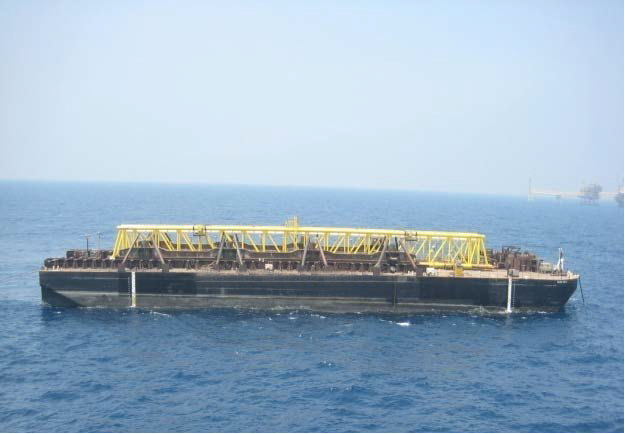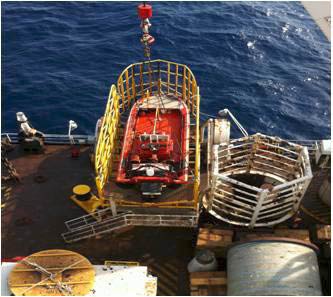Fatality after capsize of workboat with eight persons onboard
A member has reported an incident in which a workboat capsized during personnel transfer, causing seven people to fall into the sea, one of whom drowned. The workboat was transferring personnel from a vessel to a cargo barge during the hours of darkness. Weather conditions were: Wind E 16 knots; Sea state 0.7m-1.3m with period 3.8s, which conditions were considered by the member to be within acceptable parameters for this kind of operation.
The workboat approached the cargo barge from the stern portside. One person disembarked the workboat onto the cargo barge. Immediately after this, the workboat was hit by two waves from the port side; the first filling it with water and the second causing it to capsize. The person who disembarked raised the alarm by radio. Two members of the crew climbed onto the hull of the capsized workboat and unsuccessfully attempted to right the boat by operating the manual handle to the self-righting gear. The other five persons made their way to the polypropylene rope attached to the emergency tow wire located on the stern port side of the cargo barge. Of these five persons, three did not hold on and drifted away, the deceased being one of them. The other two were recovered safely onto the cargo barge. A tug vessel present in the area, closest to the cargo barge, was requested to search for and recover the lost personnel. This tug recovered the two crew members from the hull of the capsized workboat, and two crew members from the water who had been holding onto the polypropylene rope. The third missing crew member was recovered later by a supply vessel in the area but was already dead.


An investigation revealed the following:
- The problem had not been anticipated; the capsizing of this type of workboat had never occurred previously;
- The workboat had frequently been utilised in the same sea conditions including operations during the hours of darkness;
- Maintenance and inspection of the workboats was not fully in line with International Convention for the Safety of Life at Sea (SOLAS) requirements;
- Inspection of the self-righting gear revealed that the safety pin utilised to prevent activation during transportation had never been removed. Inspection of the records of the workboat manual revealed that no reference was made to this device or that it should be removed before use at sea;
- Emergency response was not adequate; thus, the full detail of the emergency was not understood by those responsible for initiating the relevant response action;
- Vessel man overboard procedures did not cover overboard scenarios remote from the vessel. Man overboard drills and exercises were limited to loss overboard from main vessel and did not consider personnel working in remote locations.
The following corrective actions were suggested:
- Ensure that a backup vessel is always present during vessel to vessel personnel transfer;
- Ensure that workboat personnel have specific personal protective equipment (PPE) for transfer operations dependent on local climate and conditions, including personal locator beacons, life-jackets, waterproof radios, work suits as appropriate, and appropriate headgear;
- Ensure that during the hours of darkness the bridge watchman has access to night vision binoculars;
- Review procedure for personnel transfer, to include clear line of command and who should authorise the launching of a workboat;
- Develop drills and exercises for man overboard scenario remote from vessel;
- Amend planned maintenance schedule to include checks of self-righting gear and develop user checklist;
- Ensure boarding arrangements on barges are properly considered before use; consider the possibility of development of improved or appropriate boat landing access on barges;
- Ensure adequate lighting is available on cargo barges;
- Identify appropriate tracking system for workboats;
- Investigate the use of alternate means of personnel transfer.
Members are reminded that IMCA has published Guidance on the transfer of personnel to and from offshore vessels and structures.
Safety Event
Published: 27 July 2011
Download: IMCA SF 08/11
IMCA Safety Flashes
Submit a Report
IMCA Safety Flashes summarise key safety matters and incidents, allowing lessons to be more easily learnt for the benefit of all. The effectiveness of the IMCA Safety Flash system depends on Members sharing information and so avoiding repeat incidents. Please consider adding [email protected] to your internal distribution list for safety alerts or manually submitting information on incidents you consider may be relevant. All information is anonymised or sanitised, as appropriate.
IMCA’s store terms and conditions (https://www.imca-int.com/legal-notices/terms/) apply to all downloads from IMCA’s website, including this document.
IMCA makes every effort to ensure the accuracy and reliability of the data contained in the documents it publishes, but IMCA shall not be liable for any guidance and/or recommendation and/or statement herein contained. The information contained in this document does not fulfil or replace any individual’s or Member's legal, regulatory or other duties or obligations in respect of their operations. Individuals and Members remain solely responsible for the safe, lawful and proper conduct of their operations.
